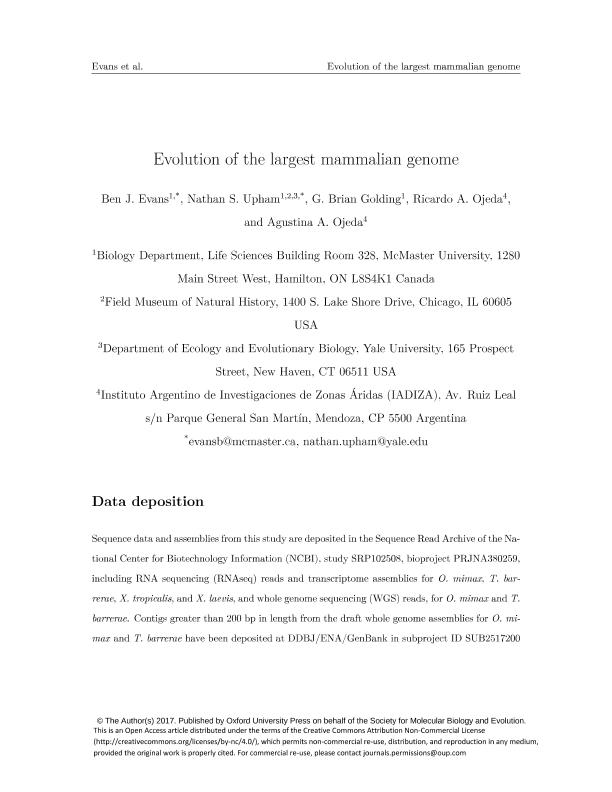Artículo
Evolution of the largest mammalian genome
Evans, Ben J.; Upham, Nathan S.; Golding, G. Brian; Ojeda, Ricardo Alberto ; Ojeda, Agustina Alejandra
; Ojeda, Agustina Alejandra
 ; Ojeda, Agustina Alejandra
; Ojeda, Agustina Alejandra
Fecha de publicación:
06/2017
Editorial:
Oxford Academic
Revista:
Genome Biology and Evolution
e-ISSN:
1759-6653
Idioma:
Inglés
Tipo de recurso:
Artículo publicado
Clasificación temática:
Resumen
The genome of the red vizcacha rat (Rodentia, Octodontidae, Tympanoctomys barrerae) is the largest of all mammals, and about double the size of their close relative, the mountain vizcacha rat Octomys mimax, even though the lineages that gave rise to these species diverged from each other only about five million years ago. The mechanism for this rapid genome expansion is controversial, and hypothesized to be a consequence of whole genome duplication or accumulation of repetitive elements. To test these alternative but nonexclusive hypotheses, we gathered and evaluated evidence from whole transcriptome and whole genome sequences of T. barrerae and O. mimax. We recovered support for genome expansion due to accumulation of a diverse assemblage of repetitive elements, which represent about one half and one fifth of the genomes of T. barrarae and O. mimax, respectively, but we found no strong signal of whole genome duplication. In both species, repetitive sequences were rare in transcribed regions as compared to the rest of the genome, and mostly had no close match to annotated repetitive sequences from other rodents. These findings raise new questions about the genomic dynamics of these repetitive elements, their connection to widespread chromosomal fissions that occurred in the T. barrerae ancestor, and their fitness effects ? including during the evolution of hypersaline dietary tolerance in T. barrerae.
Archivos asociados
Licencia
Identificadores
Colecciones
Articulos(IADIZA)
Articulos de INST. ARG DE INVEST. DE LAS ZONAS ARIDAS
Articulos de INST. ARG DE INVEST. DE LAS ZONAS ARIDAS
Citación
Evans, Ben J.; Upham, Nathan S.; Golding, G. Brian; Ojeda, Ricardo Alberto; Ojeda, Agustina Alejandra; Evolution of the largest mammalian genome; Oxford Academic; Genome Biology and Evolution; 9; 6; 6-2017; 1711-1724
Compartir
Altmétricas



